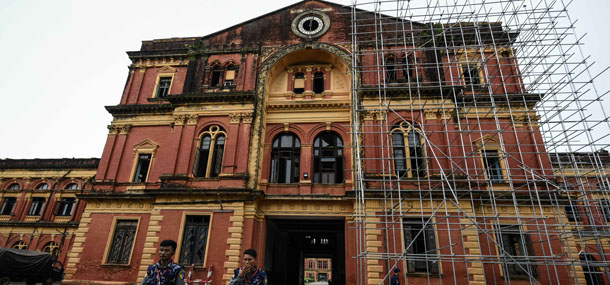RANGOON — As a child in the 1950s, Tin Tun played football on the grounds of Rangoon’s Secretariat complex, just across from his home on Bo Aung Kyaw Road, formerly Sparks Road.
“At that time, people were allowed to enter and explore the old colonial buildings. As neighborhood children, we played there in our free time,” the 71-year old said.
“I want to see the building returned to the public,” he said, sat at his residence some ten paces distant from the edge of the Secretariat compound. The redbrick colonial structure, more than 120 years old and now ringed with bamboo scaffolding, is visible beyond a fence rising from the adjoining pavement.
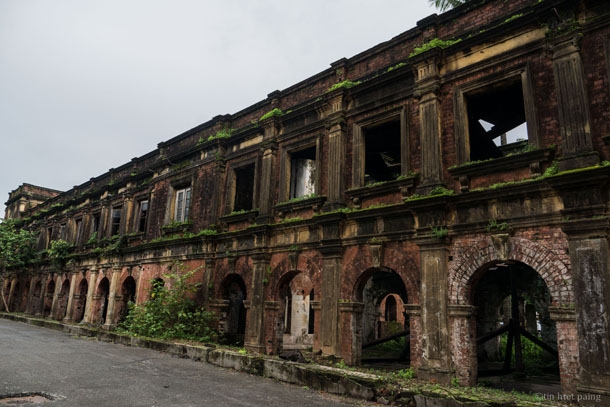
The Secretariat, sprawling for 16 acres across an entire city block in Yangon’s Botahtaung Township, is closed for renovation, having being neglected for decades by the state—despite its historical significance as the former seat of the British colonial administration, and of successive governments in independent Burma.
It was the site of the assassination of Myanmar (Burma)’s national hero Gen Aung San—the man who negotiated independence from the British—along with eight of his colleagues by a political rival in one of the second-floor rooms on July 19, 1947, a date marked annually as Martyrs’ Day.
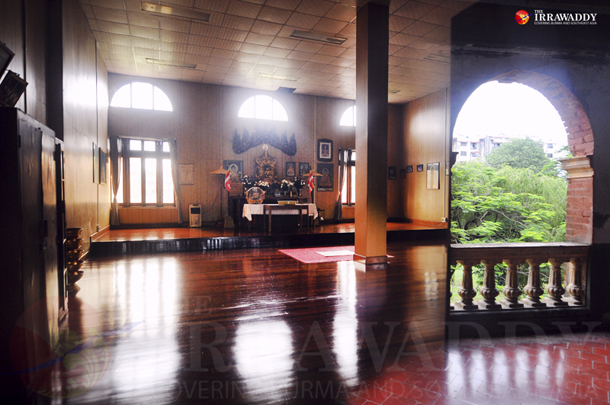
Its grounds also hosted the ceremony ushering in Myanmar’s independence, held—in line with the dictates of astrologers—at 4:20 am on January 4, 1948. Burma’s first parliament was located there.
Following the military coup in 1962, public access was severely restricted and the structure was re-branded the Ministers’ Office. It was used to house government offices up until the military junta announced the founding of a new capital, Naypyitaw, in 2005—after which it was abandoned.
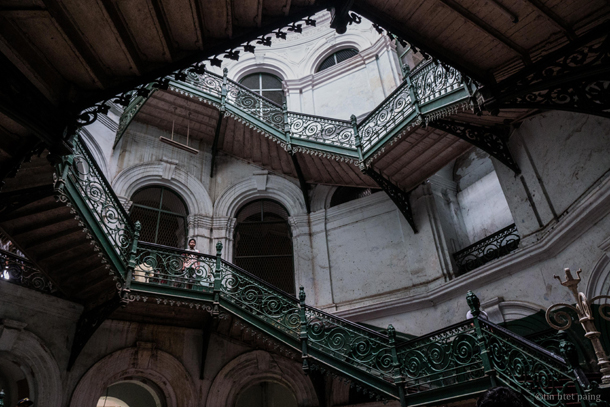
In 2010, the government undertook some limited renovation efforts and in 2011 announced plans to privatize the site along with other state-owned colonial heritage buildings in Yangon.
In 2012, the Anawmar Art Group—a company owned by family members of a former junta general, Tun Kyi—was declared the winner of a government tender for the site.
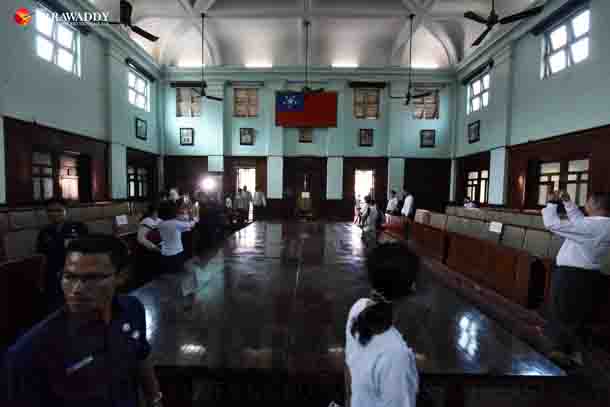
Now, after the installation of the country’s first democratically elected government in more than five decades, there are high hopes that the iconic building will be returned to the public in some form.
“I hope the elected National League for Democracy [NLD] government will consider returning the building to the public,” said Maw Lin, vice president of the Association of Myanmar Architects.
“This is a place of urban heritage, cultural heritage and historical heritage. Such buildings should be handled by the government and open to the public,” he said.
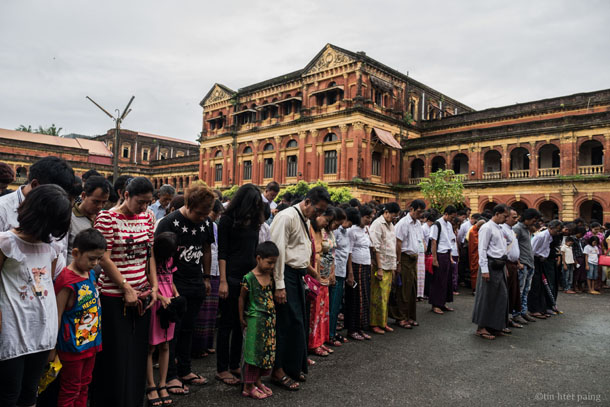
However, beyond its aesthetic qualities, architectural significance and history as a former seat of power, it figures chiefly in the minds of the Myanmar public as the site of a national tragedy—the gunning down of Gen Aung San and his comrades in 1947.
The building was opened to the public for the first time on Martyrs’ Day in 2014, remaining closed for the rest of the year. On Martyrs’ Day this year—for the third time in a row—the public was allowed in for the day. Queues stretched around the block. For the first time, the Yangon Division government put on a commemorative ceremony at the site.
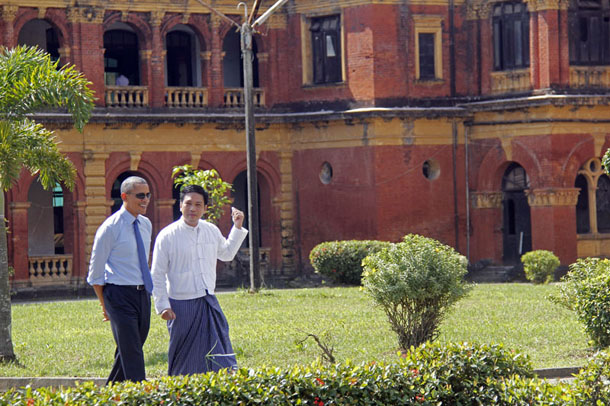
On Wednesday last week, Yangon Division Chief Minister Phyo Min Thein met with representatives of the Anawmar Art Group and the Yangon Heritage Trust, an organization that lobbies for the preservation of Rangoon’s architectural heritage, to discuss the renovation work at the complex.
Soe Thwin Tun, Anawmar Art Group director and grandson of former Lt-Gen Tun Kyi, told The Irrawaddy that, although Anawmar won the tender in 2012, renovation could only get underway after they had finished drawing up a Conservation Management Plan—in collaboration with the Yangon Heritage Trust—in October of last year.
He said they now plan to house a historical museum in the room where Gen Aung San was assassinated and in the chamber of the first parliament, to be opened to the public in time for next year’s Martyrs’ Day. Thereafter, the museum would be open three to four days a week.
“As arts and crafts collectors, we plan to open a museum. But it is not easy to cover the costs of renovating and maintaining the building with only a museum. So, from the outset, we told the [previous] government that we needed to include some commercial ventures on the site, to preserve it for the long term,” Soe Thwin Tun said.
He said US$50 million had been put toward its renovation. Alongside the museum, the company plans to open a library, to rent out parts of the structure for offices and restaurants, and to use other parts for the performance and exhibition of Myanmar’s traditional arts.
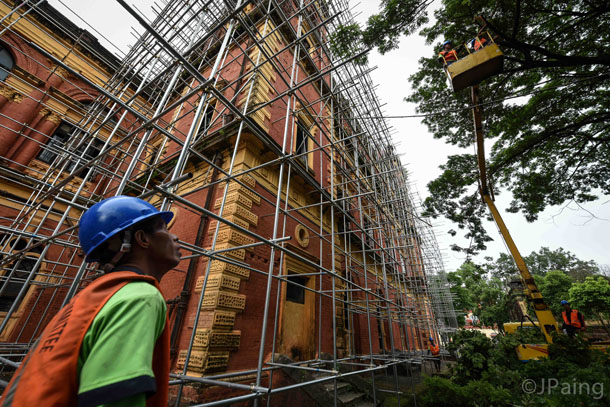
“Whether it is nationalized or privatized, our intention is to open the place to the public. We are not developing a hotel or shopping mall. We want for anyone who is interested to be able to come and visit,” Soe Thwin Tun added.
Last year, the Anawmar Art Group faced a public backlash after the grounds of the Secretariat were used to host the birthday party of Tun Kyi’s daughter, Thi Thi Tun. The organizers later claimed that the private event had been staged in order to raise funds for the renovation.
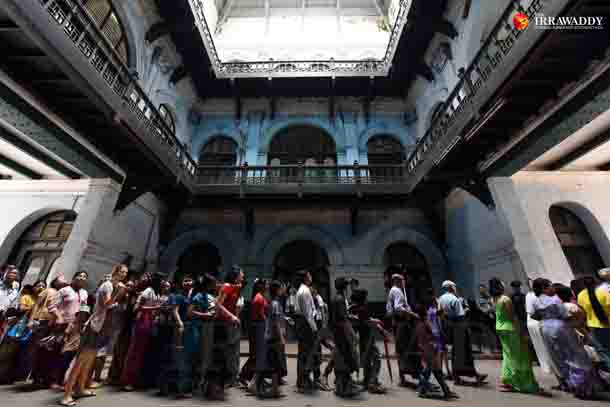
“I was really happy to see thousands of people enter the building on Martyrs’ Day. The place is part of our heritage. It shouldn’t be privatized, but should belong to the public,” said Aung Htoo, a National League for Democracy (NLD) lawmaker in the Yangon Division parliament representing Botahtaung Township, which abuts the Secretariat.
The lawmaker said he would submit a proposal for the return of the Secretariat to the public during the upcoming parliamentary session.
Nay Phone Latt, an NLD lawmaker representing Yangon’s Thingangyun Township in the divisional parliament, said that the government should review the contract made between the previous government and the Anawmar Art Group.
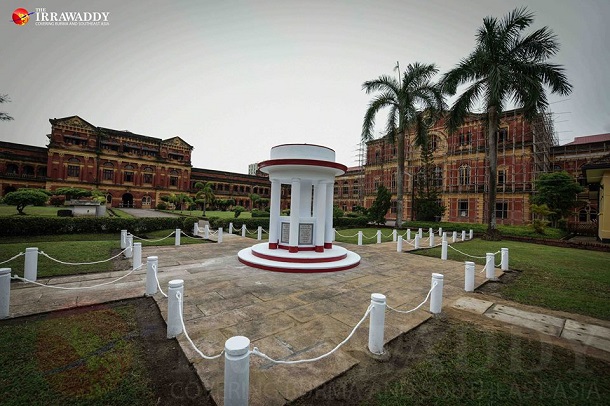
“The more significant the building is, the more safeguards are required to preserve it,” said Moe Moe Lwin, director and vice-chairman of the Yangon Heritage Trust.
“The Secretariat is of high significance not only because of its history but also its location. It sits at the heart of Rangoon [Yangon]. Its border of trees and greenery act like a lung for the city,” she said.
The Yangon Heritage Trust had lobbied for a Conservation Management Plan (CMP) before partnering with the Anawmar Art Group to develop one.
“However, we don’t have a system to monitor whether the company actually follows the CMP. The government should develop one,” Moe Moe Lwin said.
She said, that according to the CMP, Anawmar must consult with both the Yangon Heritage Trust and the government if they wish to make structural changes to the Secretariat.
Moe Moe Lwin, who is an architect by training, said they had first encouraged the government to manage the project, with the involvement of experts, the family members of the “fallen heroes” [those killed on July 19, 1947], businessmen, parliamentarians and civil society.
However, she said they would be satisfied so long as the private leaseholder prioritized heritage conservation and accessibility to the public—but income-generating ventures to ensure long-term sustainability must be “appropriate.”


